Abstract
Brazil has emerged as one of the global leaders in adopting renewable energy, standing out in the implementation of onshore wind energy and, more recently, in the development of future offshore wind energy projects. Onshore wind energy has experienced exponential growth in the last decade, positioning Brazil as one of the countries with the largest installed capacity in the world by 2023, with 30 GW. Wind farms are mainly concentrated in the northeast region, where winds are constant and powerful, enabling efficient and cost-competitive generation. Although in its early stages, offshore wind energy presents significant potential of 1228 GW due to Brazil’s extensive coastline, which exceeds 7000 km. Offshore wind projects promise greater generating capacity and stability, as offshore winds are more constant than onshore winds. However, their development faces challenges such as high initial costs, environmental impacts on marine ecosystems, and the need for specialized infrastructure. From a sustainability perspective, this article discusses that both types of wind energy are key to Brazil’s energy transition. They reduce dependence on fossil fuels, generate green jobs, and foster technological innovation. However, it is crucial to implement policies that foster synergy with green hydrogen production and minimize socio-environmental impacts, such as impacts on local communities and biodiversity. Finally, the article concludes that by 2050, Brazil is expected to consolidate its leadership in renewable energy by integrating advanced technologies, such as larger, more efficient turbines, energy storage systems, and green hydrogen production. The combination of onshore and offshore wind energy and other renewable sources could position the country as a global model for a clean, sustainable, and resilient energy mix.
1. Introduction
1.1. Contribution of Renewable Energies in Brazil
In a world increasingly aware of environmental limits and the impacts of climate change, the transition to renewable energy sources has emerged as one of the most urgent and promising strategies to ensure a sustainable future [1,2,3]. Brazil, with its vast territory, natural wealth, and an energy mix historically dominated by renewable sources, occupies a privileged place on this global stage [4,5]. However, the country faces the challenge of consolidating and expanding its clean energy capacity to maintain its leadership in this area and align its economic development with the principles of sustainability, which integrate environmental protection, social equity, and inclusive economic growth [6,7].
The Brazilian energy mix is unique worldwide due to its high renewable component, which exceeds 80% of electricity generation, driven primarily by hydroelectricity. However, this model, although clean in terms of emissions, has faced criticism for its socio-environmental impacts, such as the alteration of river ecosystems and the displacement of traditional communities [8,9]. In this context, diversification toward other renewable sources, such as wind, solar, and bioenergy, presents an opportunity to reduce these impacts and strengthen the resilience of the national energy system. Brazil has exceptional potential in these areas: its extensive coastline and semi-arid regions offer ideal conditions for wind power generation, while its solar irradiation is one of the highest on the planet, positioning it as a key player in the global energy transition [10].
In addition to its natural potential, Brazil has made significant progress in implementing public policies and regulatory frameworks that encourage investment in renewable energy [11]. Programs such as wind and solar energy auctions, tax incentives, and the promotion of research and development have allowed the country to become one of the world leaders in wind power generation, with wind farms supplying millions of homes. Likewise, bioenergy, especially from sugarcane, has established Brazil as a leader in the production of biofuels, such as ethanol, which has significantly reduced emissions from the transportation sector [12].
However, the transition to a more sustainable energy model is challenging. The expansion of renewable energy must address critical issues, such as the need to modernize transmission and distribution infrastructure, ensure the fair share of benefits for local communities from these projects, and minimize the environmental impacts associated with installing wind and solar farms. Furthermore, this transition must be carried out inclusively, ensuring that the economic and social benefits reach all sectors of the population, especially those historically marginalized.
The introduction of renewable energy in Brazil not only represents a technical response to the climate crisis, but also an opportunity to redefine the country’s development model [13]. By harnessing its clean energy potential, Brazil can reduce its dependence on fossil fuels, strengthen its energy security, and significantly contribute to mitigating climate change. At the same time, this process can boost the creation of green jobs, foster technological innovation, and promote social inclusion, aligning with the United Nations Sustainable Development Goals (SDGs) [14].
In this sense, the energy transition in Brazil should not be understood solely as a technological change, but as a comprehensive process involving all sectors of society [15]. From public policies to private initiatives, including the active participation of citizens, building a sustainable energy system requires a collective effort and a long-term vision. Brazil has the opportunity to establish itself as a global leader in the transition to a low-carbon economy, demonstrating that it is possible to reconcile economic development with environmental protection and social justice [16]. This path will benefit the country and serve as an inspiring model for other nations in their pursuit of a more sustainable and equitable future.
Brazil is prominent in the ranking of global installed onshore wind power capacity. According to 2023 data (Figure 1), the country is among the top ten in the world, alongside powerhouses such as China, the United States, Germany, and India. China has an installed capacity exceeding 400 GW, followed by the United States with over 150 GW. Brazil, with over 30 GW, is in sixth place, depending on annual fluctuations in other countries [17].
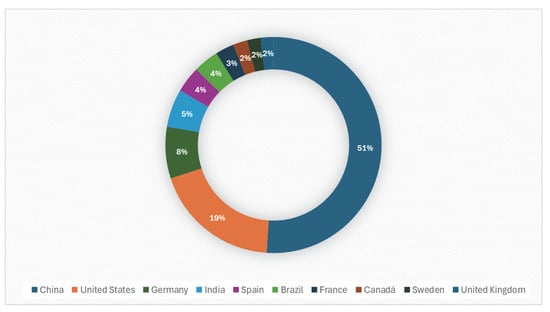
Figure 1.
Top ten world ranking onshore wind energy installed capacity.
In the Latin American context, Brazil is by far the undisputed leader in wind energy. It represents more than 70% of the region’s installed capacity, far surpassing countries such as Mexico, Chile, and Argentina, which have also advanced in this sector, albeit at a slower pace [17]. This regional leadership is due to its installed capacity, its experience in managing large-scale wind projects, and its ability to efficiently integrate this energy into its electricity grid.
1.2. Road to an Energy Matrix of Carbon Neutrality
Brazil’s energy matrix is one of the cleanest and most renewable in the world, thanks to its heavy reliance on sources such as hydroelectric, biomass, wind, and, more recently, solar [18]. However, in the global context of the climate emergency and the need to achieve carbon neutrality, Brazil faces unique challenges and opportunities to consolidate its leadership in the sustainable energy transition.
Currently, approximately 80% of Brazil’s primary energy comes from renewable sources, a figure well above the global average of around 14% [5]. Hydroelectric power is the backbone of the Brazilian electricity system, representing more than 51% of installed capacity [19] (Figure 2). However, reliance on hydroelectric power also poses risks due to the effects of climate change, especially during periods of drought, which has led to an increase in the use of natural gas and coal-fired thermoelectric plants, sources that emit greenhouse gases (GHGs) [20].
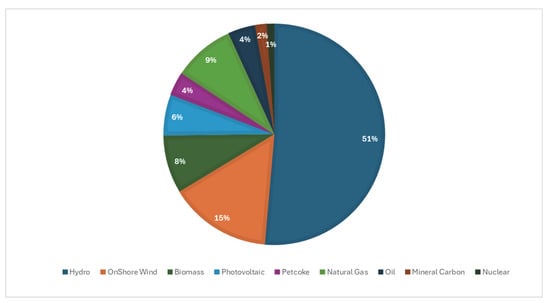
Figure 2.
Brazilian energy matrix based on renewable energies, year 2023.
On the other hand, Brazil has made significant progress in incorporating wind and solar energy, which together represent more than 20% of the electricity mix [19] (Figure 2). These sources have grown rapidly in the last decade, thanks to their economic competitiveness and the country’s natural potential, especially in regions like Northeast Brazil, where wind and solar radiation are abundant. Furthermore, biomass, primarily derived from sugarcane, plays a crucial role in energy generation and emissions reduction, as it is a renewable and sustainable source [21].
To achieve carbon neutrality, Brazil must address several challenges. First, reducing dependence on fossil fuels is essential, especially in the transportation sector, which still relies heavily on diesel and gasoline. Electrifying the vehicle fleet and promoting advanced biofuels, such as second-generation ethanol, are key measures. Furthermore, it is necessary to strengthen energy efficiency policies and promote the adoption of clean technologies in industry and the residential sector [7,8,18].
Another critical aspect is the conservation of Brazil’s biomes, especially the Amazon, which is vital in carbon capture and regulating the global climate. Deforestation and land-use changes are the main sources of GHG emissions in Brazil, so controlling them is essential for the country to achieve its climate goals [22,23].
In short, Brazil has a unique energy matrix, with a high renewable component that positions it favorably in the race toward carbon neutrality. However, to consolidate this leadership, the country must overcome challenges such as reducing dependence on fossil fuels, expanding wind and solar energy, and protecting its natural ecosystems. With appropriate public policies, investments in innovation, and a firm commitment to sustainability, Brazil can become a global model for a fair and efficient energy transition. Thus, the future of onshore and offshore wind energy is promising, given the country’s enormous wind potential and the political will to realize numerous investment projects.
Brazil has emerged as one of the world’s fastest-growing wind energy markets, leveraging exceptional natural resources and strategic investments. Unlike many countries, Brazil benefits from the following:
- High Capacity Factors: Brazil’s onshore wind farms average a capacity factor of 45–50%, surpassing the global average (~35%) and rivaling offshore wind hubs like the UK (40–50%). Regions like the Northeast boast peaks of 60%, among the highest onshore rates worldwide.
- Complementary Hydropower Integration: Unlike wind-dependent nations (e.g., Germany, USA), Brazil integrates wind with hydropower, using reservoirs as “natural batteries” to balance intermittency—a model few countries can replicate.
- Competitive Costs: Brazil’s wind energy auctions routinely secure prices below $30/MWh, cheaper than the US ($40–$50/MWh) and European markets ($50–$80/MWh).
- Global Comparison of capacity factors: Brazil (~48%), China (~35%), USA (~37%), and Germany (~22%).
- Global Comparison of key limitations: Brazil (Grid expansion), China (Curtailment), USA (Land disputes), and Germany (Low wind speeds).
Brazil’s geographical uniqueness is the following characteristics:
- Trade Winds and Coastlines: Consistent South Atlantic trade winds (6–9 m/s avg.) fuel Brazil’s Northeast, home to 80% of its wind parks.
- Low Seasonality: Unlike Europe’s winter-peak winds, Brazil’s winds peak in dry seasons (June–November), complementing hydropower shortages.
- Brazil’s combination of high productivity, low costs, and synergistic renewables integration positions it as a global benchmark for sustainable wind growth.
1.3. Aim of the Article
This article presents the advances, progress, and future perspectives of the insertion of wind energy in Brazil, considering the battle against climate change and the fulfillment of the Sustainable Development Goals (SDGs) for 2030 of the United Nations (UN). In both cases, the development of onshore wind energy and future offshore wind energy projects to be carried out in the coming years are described to meet the goals of carbon neutrality by 2050. This article has the following structure: (i) introduction, (ii) wind energy potential, (iii) onshore and offshore wind farm experiences, (iv) discussion, and (v) conclusions. Finally, this article discusses advances in battery storage systems, green hydrogen production, and sustainability challenges.
2. Potential of Wind Energy Resources in Brazil
2.1. Onshore Wind Energy Potential
Brazil has a vast territory and great geographical diversity, giving it significant wind power potential for electricity generation. Wind speeds in Brazil vary considerably by region and altitude, which is a crucial factor for wind turbine efficiency. Furthermore, other factors such as capacity factor and wind direction are crucial for optimizing wind energy production [24].
In general, the northeastern and southern regions of Brazil have the highest wind speeds, with the northeast being the most promising area for wind energy. In this region, especially in the states of Rio Grande do Norte, Bahia, and Ceará, winds are more constant and stronger, with average annual speeds that can exceed 8 m/s at an altitude of 80 m, the typical hub height of modern wind turbines. These conditions allow wind farms in these areas to achieve exceptionally high-capacity factors, sometimes exceeding 50%. The capacity factor, which represents the ratio of the energy generated to the maximum possible energy generated if the wind turbine were continuously operated at full capacity, is a key indicator of a wind farm’s efficiency. In Brazil, the average capacity factors of onshore and offshore wind farms typically range between 0.35 and 0.50, figures that are among the highest in the world, thanks to the consistency and quality of the winds [24].
The wind’s behavior concerning altitude follows a vertical profile known as the exponential law of wind speed, which indicates that wind speed increases with altitude. This is due to the reduction in friction with the Earth’s surface. In Brazil, it has been observed that at an altitude of 50 m, wind speeds can be around 6 m/s, while at 100 m, these speeds can increase to 7.5 m/s or more, depending on the region. This characteristic has led to the installation of wind turbines with taller towers and longer blades, capable of capturing stronger and more consistent winds at higher altitudes [24].
In addition to speed and height, wind direction is another critical factor in the planning and operation of wind farms. In Brazil, the prevailing winds in the most favorable regions, such as the northeast, tend to be consistent in direction, making it easier to orient wind turbines to maximize energy capture. The trade winds, which blow from the Atlantic Ocean toward the continent, are particularly important in the northeast, as they provide stable and predictable airflow. This consistency in wind direction reduces wear and tear on wind turbine yaw mechanisms and improves overall system efficiency [24].
The ability to generate electricity with wind turbines is directly related to wind speed, as wind power is proportional to the cube of the wind speed. This means that a small increase in wind speed can result in a significant increase in energy production. Therefore, areas with higher wind speeds at higher altitudes are best suited for installing wind farms. Furthermore, the combination of high-capacity factors and consistent wind direction makes Brazil one of the countries with the greatest potential for wind energy expansion [24].
Based on the 100 m wind speed map the Global Wind Atlas (GWA) provided, Brazil possesses significant wind energy potential. The most favorable wind resource conditions are concentrated mainly in the Northeast and South regions (Figure 3). Wind speeds were analyzed using the Weibull probability distribution, taking into account different altitudes and studying seasonal behavior [25].
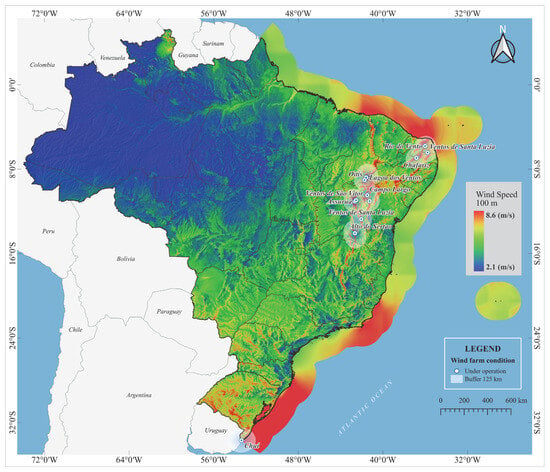
Figure 3.
Map of the wind potential at an average wind turbine height of 100 m and the location of the 10 largest wind farms under operation in Brazil.
Figure 3 also shows the 10 largest onshore wind farms in Brazil by 2025, all connected to the national interconnected electricity system (SIN).
The wind energy potential was evaluated using the following steps [26]:
- (i)
- Data Sources
- Wind Speed Data: Obtained from (e.g., meteorological stations, reanalysis datasets (ERA5, MERRA-2), and SCADA records).
- Temporal Resolution: [e.g., hourly/monthly data over 10 years].
- Spatial Resolution: [e.g., 10 m × 10 m grid for GIS-based analysis or point data from mast measurements].
- (ii)
- Wind Speed Extrapolation and Adjustment
- Adjusted to hub height (e.g., 80–120 m) using the logarithmic and power law (Weibull distribution parameters).
- Surface roughness and terrain effects were accounted for via (e.g., WAsP modeling).
- (iii)
- Software/Tools
- GIS Tools: (e.g., ArcGIS) for spatial interpolation (e.g., kriging and IDW).
- Wind Modeling Software: (e.g., WAsP Modeling) for turbine placement and wake effects.
- Statistical Tools: [e.g., R and Python] for Weibull fitting or energy yield calculations.
- (iv)
- Turbine Specifications
- Assumed turbine model (s): (e.g., Vestas V90–2.0 MW with 80 m hub height).
- Power Curve: Used manufacturer data or generic curves (IEC Class I/II/III).
- Capacity Factor: Based on site-specific wind speeds and turbine cut-in/cut-out thresholds.
- (v)
- Assumptions/Limitations
- Excluded wake losses.
- Assumed uniform wind distribution over the study area.
- Validation: Compared with SCADA data or neighboring wind farms.
The spatialization of onshore wind farms is relatively localized. The northeast region concentrates the largest number, mainly in the state of Bahia, where the following wind farms are located: (i) Alto do Sertao, (ii) Assuruá, (iii) Ventos de Santa Luzia, (iv) Campo Largo, (v) Oitis, and (vi) Ventos de São Vitor. In the state of Rio Grande do Norte, we have the (vii) Rio do Vento wind farm, while in Piauí, we have the (viii) Lagoa dos Ventos wind farm, and finally in the state of Paraiba, we have the (ix) Chafariz wind farm. Finally, in the southern region, we have a wind farm in Rio Grande do Sul called (x) Chuí (Figure 4).
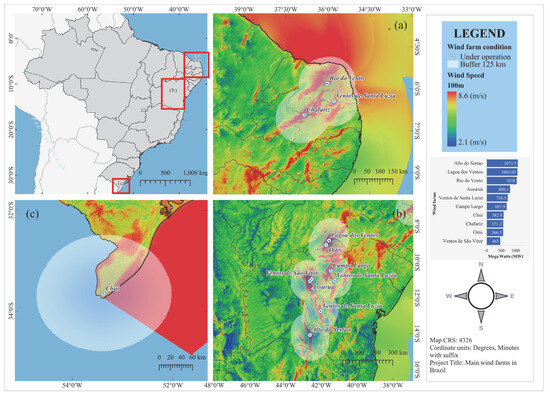
Figure 4.
Occupation of the 10 largest wind farms in the northeast and south regions of Brazil and a reference area of influence of 125 km radius: (a) northeast region, (b) east region, and (c) south region.
The speeds recorded in the Northeast and Southern regions of Brazil correspond to Classes I and II, for hub heights of 80 m and 100 m. These speeds are also called IEC 61400-1 wind turbine generator systems. Another essential characteristic of these regions is their high-capacity factors, ranging from 0.35 to 0.50 [24].
A wind project’s capacity factor (CF) is not fixed but depends on site selection, turbine technology, operational practices, and environmental conditions. Optimizing these factors can significantly enhance energy yield and economic viability. Future advancements in floating offshore wind, predictive maintenance, and AI-driven wind forecasting may further push CF boundaries.
Wind projects typically have capacity factors ranging from 25% to 50%, though some offshore or optimally sited projects can exceed 60%. Several key factors influence these variations:
- (i)
- Wind Resource Quality (Site-Specific Factors)
- Wind Speed and Consistency: Higher and more consistent wind speeds significantly boost CF. Sites with low turbulence and steady wind regimes (e.g., coastal areas, plains) perform better.
- Terrain and Surface Roughness: Complex terrain (hills, forests) disrupts airflow, reducing efficiency compared to flat, open areas (e.g., prairies or offshore sites).
- Altitude and Air Density: Higher elevations may have stronger winds, but lower air density can slightly reduce power output.
- (ii)
- Turbine Design and Technology
- Hub Height: Taller turbines access stronger, more consistent winds (wind speed increases with height due to reduced surface friction).
- Rotor Diameter and Swept Area: Larger rotors capture more wind energy, improving CF, especially in lower wind-speed regions.
- Turbine Rating and Cut-In/Cut-Out Speeds: Turbines optimized for a site’s wind profile (e.g., lower cut-in speeds for light winds) maximize output.
- (iii)
- Maintenance and Operational Strategies
- Preventive vs. Reactive Maintenance: Proactive maintenance reduces downtime, while poor upkeep leads to underperformance.
- Component Reliability: Gearbox, blade, and generator failures can drastically reduce availability and CF.
- Grid Constraints and Curtailment: Grid congestion or oversupply may force operators to curtail output, artificially lowering CF.
- (iv)
- Environmental and Seasonal Variability
- Seasonal Wind Patterns: Some regions have strong winter winds but calm summers, leading to fluctuating CF.
- Wake Effects (Wind Farm Layout): Poorly spaced turbines cause aerodynamic interference, reducing downstream turbine efficiency.
- (v)
- Offshore vs. Onshore Differences
- Offshore Wind: Typically has higher CF (40–60%) due to stronger, steadier winds and fewer obstructions.
- Onshore Wind: More variable (25–45%) due to terrain and land-use constraints.
Wind speed has a spatial and temporal distribution. Its spatial distribution depends on the roughness of the terrain, for example, the presence of trees, buildings, hills, or mountains. Temporarily, wind speed can vary during the day or night, and even more so in the early morning, morning, midday, afternoon, or evening. Figure 5 shows the representative average hourly wind speed profile for the Northeast region, considering different wind turbine hub heights [24].
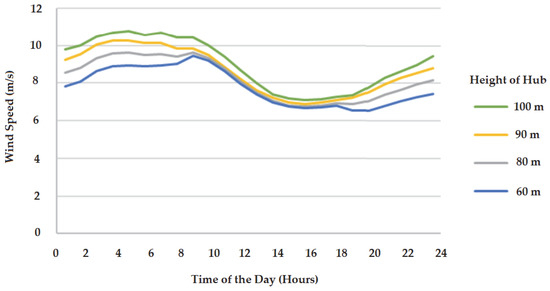
Figure 5.
Average hourly wind speed profile at different heights registered in the northeast region of Brazil.
Figure 5 shows the hourly variation in wind speed in the Northeast region of Brazil, where the highest speeds, around 10 m/s, are recorded between 2:00 a.m. and 8:00 a.m. Wind speeds decrease between 10:00 a.m. and 6:00 p.m., with minimum wind speeds around 7 m/s. Finally, wind speeds peak from 6:00 p.m. to 12:00 a.m., reaching 9 m/s. Despite the decrease in wind speed during the afternoon, the recorded speeds are considered excellent for wind turbine performance. One advantage of recording high wind speeds at night is that wind farms can contribute energy production to the electrical grid (SIN) at that time. In contrast, when wind speeds are low in the afternoon, solar photovoltaic energy can supplement energy production during daylight hours. Furthermore, the temporal distribution of wind speeds varies seasonally throughout the year, with speeds varying from lower to higher depending on whether it is autumn, winter, spring, or summer. Figure 6 shows the seasonal variation in wind speeds in northeastern Brazil. Wind speeds vary between 6 m/s and 11 m/s throughout the year, with minimum values recorded in March and April, while maximum values are observed in August. The curve shows an upward trend from May to August, with decreases in November and March [24].
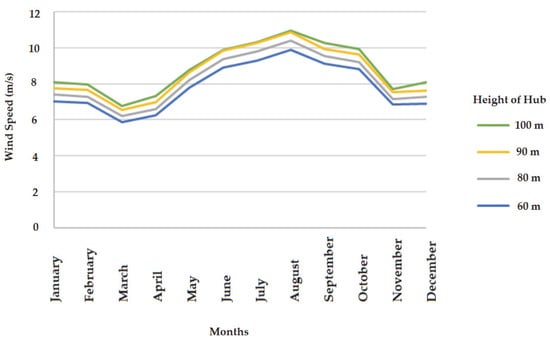
Figure 6.
Average monthly wind speed profile at different heights registered in the northeast region of Brazil.
Table 1 presents a breakdown of the estimated onshore wind energy potential for the different regions and states of Brazil [24]. The Northeast region stands out with a potential equivalent of 75.3 GW, followed by the Southeast region with 29.7 GW, the South region with 22.8 GW, the North region with 12.8 GW, and finally the Central West region with 3.1 GW.

Table 1.
State and regional onshore wind energy potential in Brazil.
Finally, it is possible to observe that the wind energy potential that Brazil has in its territory is equivalent to 143.7 GW, comparable to a hypothetical energy production of around 272.1 TWh/year, where the states that benefit most from the wind resource are Bahia with 20 GW, Rio Grande do Norte with 19.3 GW, Ceará with 15.2 GW, and Rio Grande do Sul with 15.2 GW.
2.2. Offshore Wind Energy Potential
In addition to its vast onshore wind potential, Brazil has a vast offshore wind resource that represents a significant opportunity for expanding its energy mix. Brazil’s offshore wind potential is primarily concentrated along its extensive coastline, which stretches for more than 7000 km, with favorable conditions in the northeast and southeast regions. These areas are characterized by constant, high-speed winds, making them ideal for installing offshore wind turbines [27].
In the marine environment, wind speeds tend to be higher and more constant than in onshore areas, due to the lesser roughness of the water surface and the absence of obstacles such as mountains, buildings, or vegetation. Along the Brazilian coast, especially in the northeast, average wind speeds at a height of 100 m can exceed 9 m/s, which is considerably higher than in many land-based regions. At higher altitudes, such as 150 m, these speeds can reach or even exceed 10 m/s, significantly increasing the potential for energy generation [27].
Wind behavior at sea follows a vertical profile similar to that observed on land, where wind speed increases with height. However, this increase is more pronounced in the marine environment due to lower friction. For example, while on land wind speed can increase by 10–15% when rising from 80 to 120 m in height, at sea this increase can be 20% or more. This allows offshore wind turbines, which are typically taller than onshore ones, to take advantage of stronger and more consistent winds [27].
The capacity factor of offshore wind farms in Brazil will have the potential to be extremely high, possibly exceeding 60% in the best locations. This is due to the combination of strong, constant winds and less variability in wind direction compared to onshore areas. At sea, winds are typically more unidirectional, reducing the need for frequent adjustments to wind turbine orientation and improving operational efficiency [27].
Off the northeast coast of Brazil, the trade winds, blowing off the Atlantic Ocean, are particularly consistent and strong. These winds have a predominant direction and maintain high speeds for most of the year, ensuring stable and predictable energy production. This consistency is crucial for maximizing the performance of offshore wind turbines and reducing operation and maintenance costs [27].
Figure 7 shows a map of the offshore wind resource potential in Brazil, highlighting the coastal regions with the greatest potential: the Northeast, Southeast, and South [28].
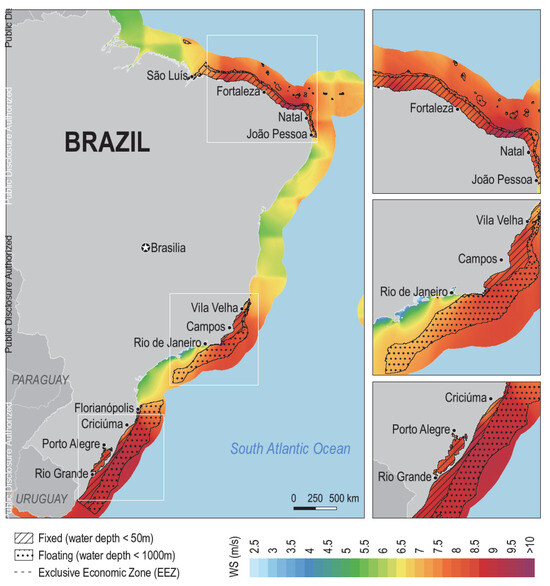
Figure 7.
Offshore wind technical energy potential in Brazil.
Figure 7 shows that installing offshore wind turbines in Brazil requires advanced technology, such as large turbines and floating or fixed platforms, depending on the water depth. In coastal areas of Brazil, where the continental shelf is relatively narrow, fixed-base wind turbines are possible. However, in areas with greater depths, such as some parts of the southern coast, floating platforms would be the most viable option [28].
There are various foundation systems for wind turbines to be implemented offshore. For shallow waters < 50 m, the following are available: (i) jacket system and (ii) monopile system. For deep waters > 50 m, the following systems are available: (i) tension leg platform, (ii) barge, (iii) semi-sub, and (iv) spar [27] (Figure 8).
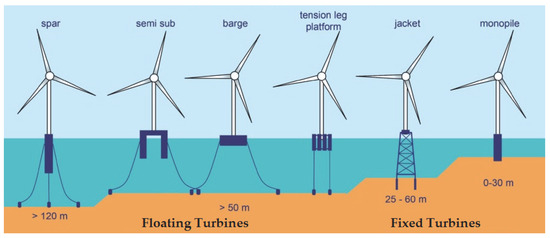
Figure 8.
Offshore wind turbines for depths < 50 m are considered fixed base installations (right), while for depths > 50 m, they are considered floating installations (left).
Overall, Brazil’s offshore wind resource potential is estimated at 480 GW for fixed-foundation wind turbine systems and 748 GW for floating wind turbine systems, resulting in a total offshore wind potential equivalent to 1288 GW [28].
Although Brazil’s offshore wind potential is enormous, its development faces challenges, such as high initial installation costs, the need for transmission infrastructure to bring offshore-generated power to the onshore grid, and environmental considerations, such as the impact on marine wildlife and bird migration routes [29,30,31]. However, with technological advancements and cost reductions in the offshore wind industry, these challenges are expected to be overcome in the medium term [27].
3. Wind Farm Projects: Experiences in Brazil
This section comprehensively analyzes the progress, challenges, and lessons learned from implementing wind farms in Brazil. This study covers currently operational onshore initiatives and offshore projects in the planning phase, highlighting technical, regulatory, and environmental aspects. Specifically, it examines the following: (i) Onshore wind farms in operation: an overview of current facilities, their installed capacity, and their contribution to Brazil’s energy matrix. (ii) Offshore projects under development: a review of initiatives in the technical studies and environmental impact assessment (EIA) stages, considering their potential and regulatory challenges.
3.1. Onshore Wind Energy Projects—In Operation (2000–2025)
Below are the ten largest onshore wind energy investment projects in Brazil, detailing their location, energy capacity, commissioning dates, and key stakeholders. These cases represent critical milestones in the expansion of renewable energy in the country, reflecting both technological advancements and the dynamics of the Brazilian energy market over the last two decades.
3.1.1. Ventos De São Vitor Wind Farm—Bahía State
The Ventos de São Vitor Wind Farm, located in the northeastern region of Brazil in Bahia State, has an installed capacity of 465 MW generated by 75 wind turbines. The facility is owned by the Brazilian subsidiary Essentia Energia. Figure 9 presents panoramic views of the wind farm, and Table 1 summarizes key technical data for this power generation facility [32]:
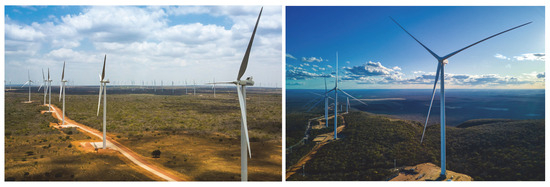
Figure 9.
Panoramic view of wind turbines on the Ventos de São Vitor wind farm.
Figure 9 reveals that the Ventos de São Vitor wind farm is near the coastal zone, without adjacent human settlements.
Based on the data in Table 2, this facility comprises 75 wind turbines produced by Siemens-Gamesa, each featuring a blade sweep diameter of 170 m. The tower heights range from 100 to 165 m, measured from the ground to the hub. Each turbine has a capacity of 5.8 MW, totaling an installed capacity of 465 MW, with a capacity factor of 0.41.

Table 2.
Ventos de São Vitor wind farm main specifications.
3.1.2. Oitis Wind Farm—Bahia and Piauí State
Located in Brazil’s northeast region, spanning the states of Bahia and Piauí, the Oitis wind farm delivers a total installed capacity of 566.5 MW, utilizing 103 wind turbines. Figure 10 presents panoramic views of the site, while Table 3 lists key technical specifications [32]:
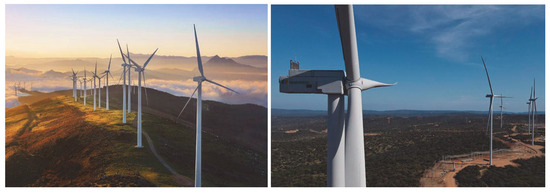
Figure 10.
Panoramic view of wind turbines on the Oitis wind farm.

Table 3.
Oitis wind farm main specifications.
Figure 10 shows that the facility is positioned in an area free of nearby human settlements.
According to Table 3, the wind farm is equipped with 103 GE Energy turbines, each with a blade sweep diameter of 158 m. The hub height ranges between 100 and 160 m. With each turbine producing 5.5 MW, the total installed capacity reaches 566.5 MW, and the capacity factor is estimated at 0.39.
3.1.3. Chafariz Wind Farm—Paraiba State
Situated in Paraíba State in northeastern Brazil, the Chafariz wind farm has an installed capacity of 571.2 MW, contributing energy to the National Interconnected System (SIN) for 20 years. Neoenergia oversees the project’s operation and concession. Figure 11 displays panoramic images, and Table 4 outlines its technical specifications [32]:

Figure 11.
Panoramic view of wind turbines on the Chafariz wind farm.

Table 4.
Chafariz wind farm main specifications.
As depicted in Figure 11, the wind farm is established in a region with agricultural activity, livestock, and nearby communities.
As shown in Table 4, the facility includes 136 Siemens-Gamesa wind turbines with a blade diameter of 132 m. Tower heights range from 120 to 150 m. Each turbine has a capacity of 3.4 MW, totaling 571.2 MW installed, with a capacity factor of 0.43.
3.1.4. Chuí Wind Farm—Rio Grande do Sul State
This wind farm is in the south region of Rio Grande do Sul state. Figure 12 shows panoramic images of the wind farm, and Table 5 provides some key technical data of this energy generation facility [32]:

Figure 12.
Panoramic view of wind turbines on Chuí wind farm.

Table 5.
Chuí wind farm main specifications.
Figure 12 indicates Chuí is situated in a region without nearby human habitation.
According to Table 5, the wind farm comprises 302 GE Energy turbines with a blade diameter of 100 m. Tower heights range from 80 to 120 m. Each turbine produces 2.0 MW, leading to a total capacity of 582.8 MW and a capacity factor of 0.35.
3.1.5. Campo Largo Wind Farm—Bahía State
Located in Bahia in northeastern Brazil, Campo Largo has an installed capacity of 687.9 MW and consists of 207 wind turbines. Panoramic views are shown in Figure 13, and Table 6 includes technical details [32].
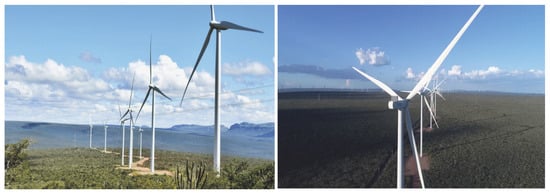
Figure 13.
Panoramic view of wind turbines on the Campo Largo wind farm.

Table 6.
Campo Largo wind farm main specifications.
As seen in Figure 13, the site is free from surrounding human settlements.
Per Table 6, the wind farm features 207 Vestas turbines, each with a 122 m sweep diameter. The towers range in height from 100 to 120 m. Each unit generates 3.3 MW, totaling 687.9 MW, with an estimated capacity factor of 0.41.
3.1.6. Ventos De Santa Luzia Wind Farm—Bahía State
The Ventos de Santa Luzia wind complex is located in the northeastern region of Brazil, in the state of Bahia. Figure 14 presents panoramic images of the wind farm, while Table 7 contains key technical data of this power generation facility [32]:

Figure 14.
Panoramic view of wind turbines on the Ventos de Santa Luzia wind farm.

Table 7.
Ventos de Santa Luzia wind farm main specifications.
As observed in Figure 14, the wind farm is situated in an area with no nearby human settlements.
According to Table 7, the facility comprises 200 wind turbines manufactured by Acciona, each with a blade sweep diameter of 125 m. From ground level to the hub, the tower height ranges between 100 and 125 m. Each turbine has a capacity of 3.6 MW, resulting in a total installed capacity of 724.5 MW and an estimated capacity factor of 0.41.
3.1.7. Assuruá Wind Farm—Bahía State
The Assuruá Wind Farm is also located in the northeastern region, within Bahia. Figure 15 shows panoramic views of the facility, and Table 8 provides essential technical data [32]:

Figure 15.
Panoramic view of wind turbines in the Assuruá wind farm.

Table 8.
Assuruá wind farm main specifications.
Figure 15 confirms that the wind farm is located without contiguous human settlements.
Technical specifications from Table 8 indicate that the facility consists of 202 Siemens-Gamesa wind turbines with rotor blades spanning 145 m in diameter. The turbine towers are constructed at varying heights between 100 and 120 m. With each unit rated at 4.0 MW, the entire wind farm achieves a combined installed capacity of 808.1 MW. Operational data suggest an estimated capacity factor of 0.41, reflecting efficient energy production relative to its potential maximum output.
3.1.8. Rio Do Vento Wind Farm—Rio Grande do Norte State
Located in Brazil’s northeastern region within Rio Grande do Norte state, the Rio do Vento Wind Farm is showcased in Figure 16 through panoramic imagery, while Table 9 outlines its critical technical parameters [32]:
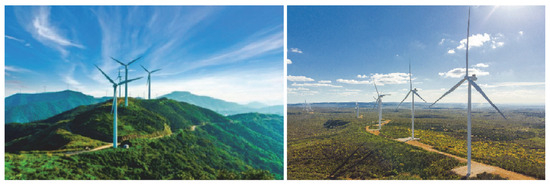
Figure 16.
Panoramic view of wind turbines on the Rio do Vento wind farm.

Table 9.
Rio do Vento wind farm main specifications.
Figure 16 shows that the wind farm is situated in an area with no adjacent human settlements.
As detailed in Table 9, the project incorporates 240 Vestas wind turbines, each featuring a 150 m rotor diameter. The towers are installed at heights ranging from 90 to 110 m. Each turbine delivers 4.2 MW of power, culminating in a substantial total installed capacity of 1038 MW. The estimated capacity factor of 0.37 indicates consistent energy generation, accounting for regional wind patterns and operational efficiency.
3.1.9. Lagoa Dos Ventos Wind Farm—Piaui State
The Lagoa dos Ventos Wind Farm is located in the state of Piauí, in the northeastern region of Brazil. Figure 17 offers a panoramic view of the site, while Table 10 summarizes the key technical characteristics of this facility [32]:
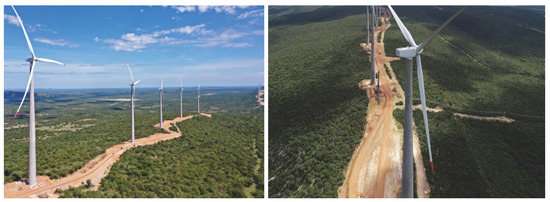
Figure 17.
Panoramic view of wind turbines on Lagoa dos Ventos wind farm.

Table 10.
Lagoa dos Ventos wind farm main specifications.
Figure 17 indicates that the wind farm is in an area free from nearby human settlements.
According to Table 10, the site has 302 wind turbines manufactured by Acciona, each with a blade sweep diameter of 145 m. The tower height ranges from 90 to 110 m. Each turbine has an installed capacity of 3.5 MW, totaling 1063.05 MW of installed capacity, with an estimated capacity factor of 0.39.
3.1.10. Alto Do Sertao Wind Farm—Bahía State
Located in Bahia, the Alto do Sertão Wind Farm is part of Brazil’s northeastern energy infrastructure. Figure 18 presents a panoramic view of the site, and Table 11 details key technical information [32]:

Figure 18.
Panoramic view of wind turbines in the Alto do Sertao wind farm.

Table 11.
Alto do Sertao wind farm main specifications.
Figure 18 shows that the Alto do Sertao wind farm is located in an area with no contiguous human settlements.
According to Table 11, the facility consists of 565 wind turbines manufactured by GE Energy, with a blade sweep diameter of 155 m. The towers range in height from 100 to 120 m. Each turbine unit delivers a rated power output of 2.0 MW under standard operating conditions. When aggregated across the entire installation, this configuration achieves a significant total installed capacity of 1073.5 megawatts, positioning the facility as a major contributor to regional renewable energy generation. The project’s estimated capacity factor of 0.41 indicates robust operational performance.
3.1.11. Resume of the Total Installed Capacity of Wind Energy in 2025
Table 12 summarizes the main characteristics of onshore wind farms operating in Brazil, including their installed capacities and the national total for wind power [32]:

Table 12.
Onshore wind farm project in operation in Brazil by 2024.
According to Table 12, by 2024, Brazil’s 10 largest onshore wind farms will be in operation. The wind farm with the lowest installed capacity is Ventos de São Vitor with 465 MW, while Alto do Sertão has the highest capacity, at 1073.5 MW. These 10 wind farms represent a total installed capacity of 7580.55 MW.
In Figure 19, it is possible to see a summary indicating the amount of annual energy generated in GWh and the capacity factor of each onshore wind farm that is in operation in Brazil.
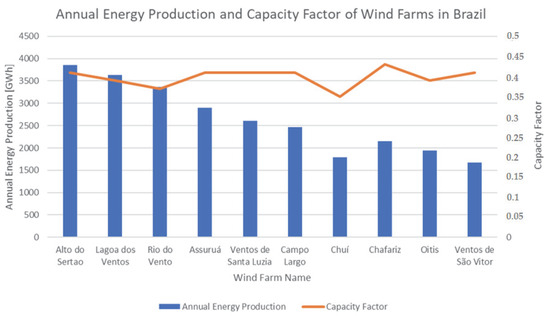
Figure 19.
Comparative graph for annual energy production and capacity factor for onshore wind farms in Brazil.
As indicated in Figure 19, the highest annual energy production comes from Alto do Sertão, with approximately 3855 GWh, while Chuí has the lowest, with 1786 GWh. The capacity factors range between 0.35 (Chuí) and 0.43 (Chafariz).
Lastly, Figure 20 illustrates the historical evolution of installed onshore wind capacity in Brazil, in megawatts [33].
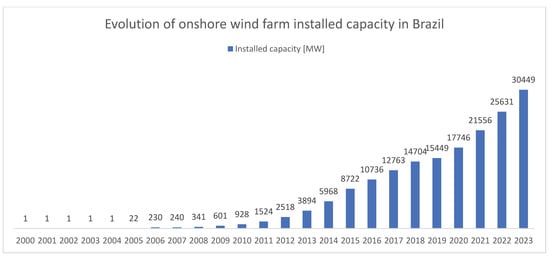
Figure 20.
Evolution over time (years) of Brazil’s onshore wind farm installed capacity (MW).
Based on Figure 20, it can be observed that the implementation of wind energy in Brazil began to intensify in 2005, with steady growth from 2013 to 2023.
Finally, Table 13 ranks the 10 Brazilian states with the highest installed capacity, indicating their geographic distribution, number of wind complexes, and number of turbines [33].

Table 13.
Installed capacity, number of onshore wind farms, and number of turbines by state in Brazil by 2023.
According to Table 13, the states currently leading the way in onshore wind energy integration are (i) Bahia with 9.87 GW, (ii) Rio Grande do Norte with 8.33 GW, (iii) Piauí with 4.58 GW, (iv) Ceará with 3.29 GW, and (v) Rio Grande do Sul with 1.83 GW. The estimated number of wind farms is approximately 1019 and 11,057. Thus, in the last year, Brazil has climbed one position in the ranking of the ten countries with the greatest installed onshore wind capacity, according to the Global Wind Energy Council (GWEC) report. In 2023, 110 new wind farms will be installed, a record for wind energy installation in Brazil. The country also ranked third in the world for wind farm installations, according to data from the Global Wind Energy Council (GWEC). Brazil now has 1019 wind farms and more than 11,057 wind turbines across 12 of its 27 states. According to the latest report published by ABEEólica, most are in the country’s Northeast region [33].
3.2. Offshore Wind Energy Projects—Future Facilities (2025–2050)
As described above, offshore wind energy projects are expected to complement the capacity of existing onshore wind energy projects in Brazil. To this end, the plan is to complement the existing electrical transmission infrastructure, including transmission towers, onshore and offshore electrical substations, and power cables [27] (Figure 21).
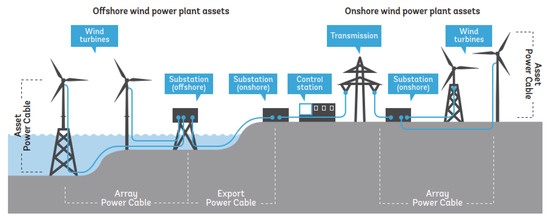
Figure 21.
Electrical infrastructure projected in Brazil for onshore and offshore wind energy.
Brazil’s future mega-electric infrastructure will supply energy to coastal and inland communities.
According to Figure 22 below, the Brazilian regions with the greatest potential and offshore wind farm projects submitted for environmental assessment are (i) the Northeast region with the states of Rio Grande do Norte and Bahia; (ii) the Southeast region with the state of Rio de Janeiro; and (iii) the South region with the state of Rio Grande do Sul [27].

Figure 22.
Offshore wind projects in different regions of Brazil.
In the following Table 14, the largest offshore wind farm projects with a process of Environmental Impact Assessment (EIA), which are in progress in 2025, are shown [33]:

Table 14.
Offshore wind farm projects in Brazil are expected for the period 2025–2050.
Considering Table 14 above, the project with the largest projected installed capacity is around 6500 MW. In most cases, the installed turbine capacity exceeds 10 MW, and the turbine hub heights are expected to be around 150 m.
Offshore wind energy has positioned itself as one of the renewable energy sources with the greatest growth potential globally. Brazil, with its extensive coastline and favorable climatic conditions, is no exception. Analyzing hourly wind speed profiles and capacity factors in different regions of the country is essential for optimizing the design and location of future offshore wind farms [27].
Northeast Brazil is known for its high levels of solar irradiation and consistent winds, making it one of the most promising areas for wind energy onshore and offshore. Hourly wind speed profiles in this region show a tendency toward higher speeds during the afternoon and evening, with an annual average of 8 and 10 m/s in coastal areas and offshore platforms. These winds are driven by the trade winds, which are consistent throughout the year [27] (Figure 23).
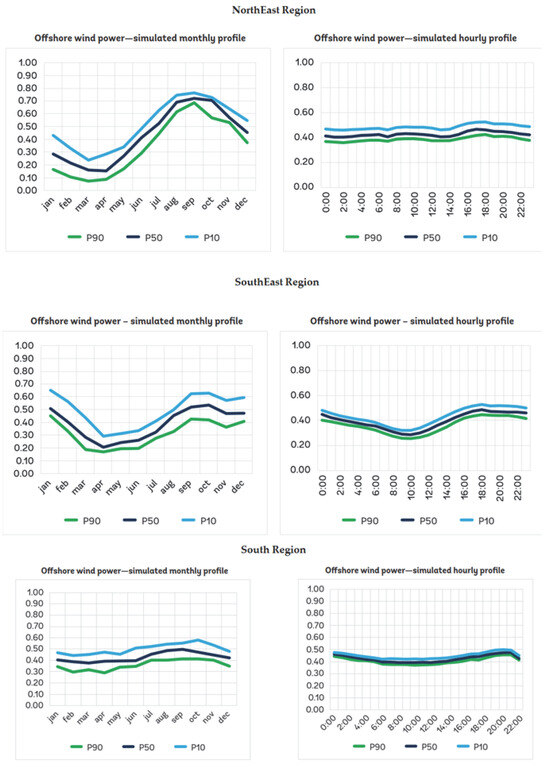
Figure 23.
Simulation of capacity factors of offshore wind energy in different regions of Brazil.
The capacity factor in this region can approach 50%, making it highly competitive internationally. However, it is important to consider seasonal variability, as winds can decrease slightly during the rainy season (between March and July). Even so, the overall stability of the winds and the proximity to consumption centers in cities such as Fortaleza and Recife make the Northeast a priority region for offshore wind development [27].
The Southeast of Brazil, which includes states such as Rio de Janeiro and São Paulo, presents more variable conditions than the Northeast. Hourly wind speed profiles in this region show a greater influence of frontal systems and sea breezes, with average speeds ranging between 6 and 8 m/s. Winds tend to be strong during the early morning and early afternoon hours, with a slight decrease in the afternoon [27] (Figure 23).
The capacity factor in the Southeast is generally lower than in the Northeast, hovering around 25–45%. This is due to greater variability in wind patterns and the influence of meteorological phenomena such as cold fronts, which can alter the consistency of the wind resource. However, the proximity to the country’s main industrial and economic centers, such as São Paulo and Rio de Janeiro, justifies investment in offshore wind farms in this region, provided the technology is optimized to adapt to these conditions [27].
The Southern region of Brazil, which includes states such as Santa Catarina and Rio Grande do Sul, is characterized by a greater influence of extratropical systems and cold fronts, which generate stronger and more constant winds during the winter. Hourly wind speed profiles show significant peaks at night and early morning, with average speeds reaching 9 m/s in offshore areas [27] (Figure 23).
The capacity factor in this region is comparable to that of the Northeast, with values that can exceed 50%, especially during the winter months. However, seasonal variability is more pronounced, with a notable decrease in winds during the summer. Despite this, the Southern region offers great potential for offshore wind energy, especially when combined with energy storage systems to offset seasonal fluctuations [27].
4. Discussion
4.1. Progress
The integration of the wind energy industry in Brazil has seen significant progress over the past two decades, becoming a key component of the country’s energy mix. Below, its impact is analyzed from the social, environmental, economic, and political perspectives:
In social terms [13,34,35], the progress of wind energy has been in the following:
- Job creation: The wind energy industry has created thousands of direct and indirect jobs, especially in northeastern regions such as Rio Grande do Norte, Bahia, and Ceará, where most wind farms are located. This has contributed to the revitalization of local economies.
- Community development: Some projects include social programs, such as improving local infrastructure and providing education and technical training for nearby communities.
- Social conflicts: In some cases, there have been tensions over land use, especially in areas where traditional or indigenous communities have seen their territories affected.
In environmental terms [8,9,10,36], wind energy progress has been achieved in the following:
- Emissions Reduction: Wind energy has helped Brazil reduce its dependence on fossil fuels, lowering greenhouse gas emissions and contributing to the country’s climate commitments.
- Local Impacts: Although it is a clean energy source, installing wind farms can affect local ecosystems, such as wildlife (especially birds and bats) and vegetation. However, environmental impact studies are mandatory to minimize these effects.
- Complementarity with other sources: Wind energy in Brazil has a high-capacity factor (around 40–50%), thanks to its constant winds, and complements hydroelectric power well, especially during drought.
In economic terms [18,19,36,37], wind energy progress has been achieved in the following:
- Investment Attraction: Brazil has attracted foreign and local investment in the wind energy sector, thanks to energy auctions and favorable policies. The country is one of the leaders in wind energy in Latin America.
- Cost Reduction: Wind power generation costs have decreased significantly, making it one of the country’s most competitive energy sources.
- Diversification of the Energy Matrix: Wind power has helped reduce dependence on hydropower, which has improved the resilience of the Brazilian energy system to droughts.
In terms of policy [15,38,39,40], wind power progress has been achieved in the following:
- Incentive Policies: The Brazilian government has implemented renewable energy policies and auctions that have fostered the growth of the wind sector. The Alternative Electric Energy Sources Incentive Program was an initial milestone.
- International Commitments: Brazil has used the expansion of wind power to meet its climate commitments, such as the Paris Agreement, and to position itself as a global leader in renewable energy.
- Regulatory challenges: Although there has been progress, some experts point to the need for improved regulation to facilitate the integration of wind energy into the electricity grid and streamline environmental licensing processes.
The wind energy industry in Brazil has had a positive economic and environmental impact, contributing to energy diversification and emissions reduction. However, social and political challenges persist, such as the need to balance development with the rights of local communities and improve energy transmission infrastructure. Even so, the sector remains a key pillar for the country’s energy transition.
A comparative Levelized Cost of Energy (LCOE) study for onshore and offshore wind projects is as follows in Table 15:

Table 15.
Comparative levelized cost of energy (LCOE) for onshore and offshore wind projects.
Some conclusions of the above comparative analysis are as follows:
- Onshore wind remains the cheapest due to lower CAPEX and mature infrastructure.
- Offshore wind is 2–3 more expensive but offers higher capacity factors and coastal proximity.
- Floating offshore is the most expensive but could become viable with cost reductions (e.g., local manufacturing).
Brazil’s onshore wind is highly competitive (~$50/MWh in best regions), while offshore wind may only be justified long-term if costs decline or coastal demand justifies higher costs.
4.2. Sustainability Challenges
The wind energy industry in Brazil has grown exponentially in recent years, consolidating its position as one of the country’s main sources of renewable energy. However, this growth brings sustainability challenges that must be addressed to ensure the sector is truly sustainable in the long term. These challenges include (i) the adoption of circular economy principles, (ii) the implementation of battery energy storage systems (BESSs), (iii) improving energy efficiency throughout the value chain, and (iv) overcoming socio-environmental barriers to the introduction of offshore wind energy [41,42,43,44].
Regarding circular economy aspects in the wind industry, one of the greatest challenges facing the wind industry is the lifecycle management of wind turbines, especially concerning the waste generated during turbine manufacturing, operation, and decommissioning. Wind turbine blades, made of composite materials such as fiberglass and resins, are particularly difficult to recycle [45]. The lack of infrastructure and specialized technologies for recycling these materials in Brazil represents a significant obstacle. Adopting a circular economy approach is essential to addressing this problem. This involves designing turbines with more sustainable materials, promoting the reuse of components, and developing efficient recycling chains. Furthermore, it is necessary to foster collaboration between manufacturers, governments, and research centers to create innovative solutions to close the life cycle of materials used in the wind industry.
Considering aspects of battery energy storage systems (BESSs), wind intermittency is an inherent characteristic of wind energy, posing challenges for the electrical grid’s stability. Battery energy storage systems (BESSs) are a promising solution to this problem, as they allow the storage of surplus energy generated during periods of high production and its release when demand is higher or generation is low. However, the implementation of BESSs in Brazil faces several challenges. First, the costs associated with these technologies are still high, limiting their large-scale adoption. Furthermore, battery manufacturing involves using critical materials, such as lithium and cobalt, whose extraction and processing have significant environmental and social impacts. To overcome these obstacles, it is crucial to invest in research and development of more efficient, sustainable, and economical batteries, as well as in policies that incentivize their adoption [42].
Energy efficiency in the value chain is another fundamental pillar of the sustainability of the wind industry. Although the energy generated by turbines is clean, the equipment’s manufacturing, transportation, and installation processes consume large amounts of energy, often from non-renewable sources. Optimizing these processes using renewable energy in manufacturing, improving logistics, and adopting more efficient technologies can significantly reduce the sector’s carbon footprint. Furthermore, integrating smart energy management systems can improve the operational efficiency of wind farms. These systems, based on artificial intelligence and data analysis, make it possible to predict wind patterns, optimize energy production, and reduce waste [46,47,48].
Introducing offshore wind energy in Brazil presents a series of advantages and disadvantages that must be carefully considered. The main positive and negative aspects of this type of energy in the Brazilian context are detailed below in Table 16 [49]:

Table 16.
Advantages and disadvantages of offshore wind farms considering the site-specific conditions of Brazil.
Finally, introducing offshore wind energy in Brazil offers a significant opportunity to diversify the energy mix and move toward a more sustainable future. However, it is crucial to effectively address the technical, economic, and environmental challenges to maximize benefits and minimize negative impacts. Collaboration between government, industry, and local communities will be key to the success of these projects.
4.3. Future Directions
With its vast coastline and favorable climatic conditions, Brazil has begun to explore the potential for green hydrogen production using offshore wind energy (Figure 24). This approach combines two key technologies for energy transition: renewable energy generation and hydrogen production as a clean energy carrier. However, while there are promising advances, there are also significant limitations that must be overcome.
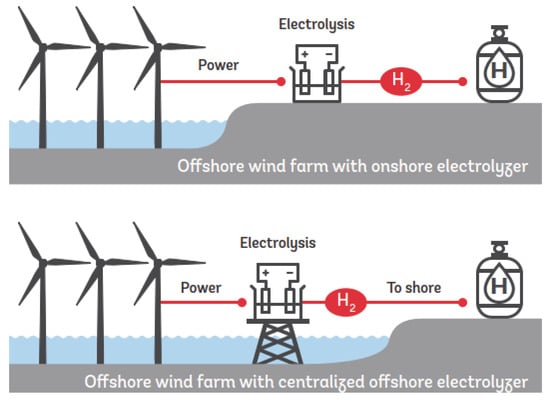
Figure 24.
Brazil is projected to develop a green hydrogen production infrastructure for offshore wind energy.
Some advances in green hydrogen production using offshore wind energy include the following [50,51,52,53,54]:
- Offshore Wind Potential: Brazil has one of the longest coastlines in the world, with over 7000 km of coastline. The northeastern regions feature consistent, high-speed winds, which are ideal for offshore wind power generation. Recent studies indicate that offshore wind potential in Brazil could exceed 1228 GW, providing a solid foundation for green hydrogen production.
- Pilot Projects and Strategic Partnerships: Brazilian and multinational companies have begun investing in pilot projects to integrate offshore wind energy with green hydrogen production. For example, Petrobras and other energy companies are exploring these projects’ technical and economic feasibility. Partnerships with countries such as Germany and the Netherlands, leaders in wind and hydrogen technology, facilitate knowledge and technology transfer.
- Regulatory Framework Under Development: The Brazilian government has begun establishing a regulatory framework for offshore wind energy, a crucial step in attracting investment. In 2022, preliminary regulations for installing and operating offshore wind farms were published. Additionally, Brazil is working on a national green hydrogen strategy, which includes tax and financial incentives for renewable energy projects.
- International Demand: Global interest in green hydrogen is growing, especially in Europe and Asia, where decarbonization is a priority in heavy industry and transportation sectors. With its wind power potential, Brazil could position itself as a key exporter of green hydrogen.
- Low Production Costs: Brazil has one of the world’s lowest green hydrogen production costs, making it very competitive. It is expected that by 2030, Brazil could produce green hydrogen at $1.45 per kilogram, making it one of the cheapest in the world.
On the other hand, some current limitations in the production of green hydrogen with offshore wind energy are the following [50,51,52,53,54]:
- High Investment Costs: Installing offshore wind farms and electrolysis plants to produce green hydrogen requires significant initial investments. The costs of offshore wind technology and electrolyzers remain high, although they are expected to decrease over time. Developing port infrastructure and power transmission from wind farms to the coast also entails considerable expenses.
- Technological Challenges: The production of green hydrogen through electrolysis requires large amounts of renewable energy. Although Brazil has enormous wind potential, wind intermittency and the need for energy storage are technical challenges that must be addressed. Furthermore, hydrogen transportation and storage are complex due to low energy density and high volatility.
- Lack of Specialized Infrastructure: Brazil does not yet have the necessary infrastructure for the large-scale production, storage, and export of green hydrogen. This includes specialized ports, transportation networks, and cryogenic storage systems for green hydrogen or ammonia.
- Competition with Other Energy Sources: Although green hydrogen holds promise, it competes with other forms of hydrogen production, where gray hydrogen (produced from fossil fuels) remains cheaper, hindering the competitiveness of green hydrogen in the short term.
Despite limitations in its prospects, Brazil has unique potential to become a global leader in green hydrogen production through offshore wind energy. To achieve this, the following are necessary: (i) Investment in Research and Development: reducing the costs of electrolysis technology and improving the efficiency of hydrogen storage and transportation systems; (ii) Clear Public Policies: establishing a solid regulatory framework and offering tax incentives to attract private investment; (iii) International Collaboration: leveraging partnerships with leading countries and companies in wind and hydrogen technology; and (iv) Sustainable Approach: ensuring that projects are developed in an environmentally responsible and socially inclusive manner.
Finally, it is worth mentioning that the production of green hydrogen through offshore wind energy in Brazil is a promising opportunity, but it requires overcoming technical, economic, and environmental challenges. With proper planning and the commitment of all stakeholders, Brazil could play a key role in the global transition to a low-carbon economy.
5. Conclusions
The introduction of onshore wind energy, offshore wind energy, and green hydrogen production in Brazil marks a significant milestone in transforming its energy mix toward a more sustainable and diversified model. Brazil has demonstrated remarkable growth in the field of onshore wind energy, consolidating its position as one of the main players in Latin America and the world. The Northeast regions, in particular, have taken advantage of their climatic and geographical conditions to become hubs for wind power generation, significantly reducing greenhouse gas emissions and strengthening the local economy by creating jobs and attracting investment.
Regarding offshore wind energy, although still in its early stages, its potential is enormous. Brazil’s extensive coastline offers ideal conditions for developing this technology, which could position the country as a leader in this sector in the future. However, addressing challenges such as regulation, implementation costs, and potential environmental impacts is essential to ensure sustainable and efficient growth. Finally, green hydrogen production is emerging as a strategic complement to wind energy onshore and offshore. With its abundant wind and solar resources, Brazil has the potential to become a global exporter of green hydrogen, a key energy vector for decarbonizing energy-intensive sectors such as industry and transportation. The synergy between renewable energy generation and green hydrogen production will strengthen the country’s energy security and open up new economic and technological opportunities.
These advances reflect Brazil’s commitment to the energy transition and sustainability. To maximize its potential, it will be essential to strengthen public policies, foster collaboration between the public and private sectors, and drive technological innovation. With an integrated and strategic approach, Brazil is well-positioned to lead the global energy revolution, contributing to a cleaner, more resilient, and sustainable future.
The introduction of wind energy in Brazil has experienced significant growth in recent decades, positioning the country as a leader in renewable energy in Latin America. This progress responds to global environmental commitments and a political strategy aimed at diversifying the energy mix, reducing historical dependence on hydroelectric sources, and fostering regional development, especially in the Northeast.
Politically, wind energy expansion has been driven by favorable regulatory frameworks, tax incentives, and public–private partnerships, reflecting a desire to integrate sustainability and economic growth. However, challenges remain, such as the need for greater coordination between government levels, transmission infrastructure improvements, and equitable distribution of local benefits. Furthermore, the success of this model depends on the continuity of state policies, beyond partisan political cycles, to ensure long-term investments.
Ultimately, wind energy in Brazil represents a paradigmatic case of how political decisions can drive the energy transition. However, its consolidation will require greater institutional coordination, transparency in bidding processes, and a social approach ensuring economic profitability does not overshadow community development. The future of this sector will depend on the ability to maintain it as a priority on the national political agenda, balancing economic, environmental, and social interests.
Author Contributions
Conceptualization, C.C.; formal analysis, C.C., M.N. and D.C.; investigation, C.C., M.N. and D.C.; resources, C.C., M.N. and D.C.; writing—original draft preparation, C.C., M.N. and D.C.; writing—review and editing, C.C., M.N. and D.C.; visualization, C.C., M.N. and D.C.; supervision, C.C. All authors have read and agreed to the published version of the manuscript.
Funding
The Research Department of Catholic University of Temuco, Chile funds the research.
Data Availability Statement
Not applicable.
Conflicts of Interest
The authors declare no conflicts of interest.
Abbreviations
| SDGs | Sustainable Development Goals |
| UN | United Nations |
| GWEC | Global Wind Energy Council |
| GHG | Greenhouse Gas |
| CO2eq | Carbon Dioxide equivalent |
| NDCs | Nationally Determined Contributions |
| SIN | National Interconnected Electricity System of Brazil |
| GWA | Global Wind Atlas |
| CF | Capacity Factor |
| EIA | Environmental Impact Assessment |
| CONAMA | Brazilian National Environment Council |
| IBAMA | Brazilian Institute of Environment and Renewable Natural Resources |
| MMA | Ministry of Environment |
| ANEEL | Brazilian Electricity Regulatory Agency |
| IRENA | International Renewable Energy Agency |
| ESMAP | Energy Sector Management Assistance Program |
| EPC | Engineering, Procurement, and Construction |
| RER | Renewable Energy Resources |
| EEZ | Exclusive Economic Zone |
| GH2 | Green Hydrogen |
| LCOE | Levelized Cost of Energy |
| MW | Megawatts |
| GW | Gigawatts |
| MWh | Megawatts-Hour |
| GWh | Gigawatts-Hour |
| Mt | Millions of tons |
| masl | Meters above sea level |
References
- Barthelmie, R.J.; Pryor, S.C. Climate change mitigation potential of wind energy. Climate 2021, 9, 136. [Google Scholar] [CrossRef]
- Borowski, P.F. Mitigating Climate Change and the Development of Green Energy versus a Return to Fossil Fuels Due to the Energy Crisis in 2022. Energies 2022, 15, 9289. [Google Scholar] [CrossRef]
- Solé, J. Climate and Energy Crises from the Perspective of the Intergovernmental Panel on Climate Change: Trade-Offs between Systemic Transition and Societal Collapse? Sustainability 2023, 15, 2231. [Google Scholar] [CrossRef]
- de Jong, P.; Barreto, T.B.; Tanajura, C.A.S.; Kouloukoui, D.; Oliveira-Esquerre, K.P.; Kiperstok, A.; Torres, E.A. Estimating the impact of climate change on wind and solar energy in Brazil using a South American regional climate model. Renew. Energy 2019, 141, 390–401. [Google Scholar] [CrossRef]
- de Lima Camargo, F.; Dos Santos, N.C.; da Silva, R.G. Wind energy in Brazil: Current overview and projections on power generation. Renew. Energy Power Qual. J. 2019, 17, 257–261. [Google Scholar] [CrossRef]
- da Silva, N.F.; Rosa, L.P.; Freitas, M.A.V.; Pereira, M.G. Wind energy in Brazil: From the power sector’s expansion crisis model to the favorable environment. Renew. Sustain. Energy Rev. 2013, 22, 686–697. [Google Scholar] [CrossRef]
- Gonçalves, S.; Rodrigues, T.P.; Chagas, A.L.S. The impact of wind power on the Brazilian labor market. Renew. Sustain. Energy Rev. 2020, 128, 109887. [Google Scholar] [CrossRef]
- Araújo, R.D.; Gorayeb, A. Perception of the socio-environmental impacts caused by wind generators in the state of Piauí, Northeast of Brazil. Sustain. Debate 2023, 14, 52–69. [Google Scholar] [CrossRef]
- Hernandez C, O.M.; Shadman, M.; Amiri, M.M.; Silva, C.; Estefen, S.F.; La Rovere, E. Environmental impacts of offshore wind installation, operation and maintenance, and decommissioning activities: A case study of Brazil. Renew. Sustain. Energy Rev. 2021, 144, 110994. [Google Scholar]
- Pereira, C.G.; Falcão, F.; Bernard, E. One size doesn’t fit all: Singularities in bat species richness and activity patterns in wind-energy complexes in Brazil and implications for environmental assessment. Zoologia 2022, 39, e21041. [Google Scholar] [CrossRef]
- Ottoni, A.; Salles, T.; Tolentino, L.; Santos, D.; Campos, A.F. Consolidation of the wind energy sector in the Brazilian electricity matrix: Opportunities, advantages and challenges. Int. J. Innov. Sustain. Dev. 2019, 13, 392–409. [Google Scholar]
- Nadaleti, W.C.; dos Santos, G.B.; Lourenço, V.A. Integration of renewable energies using the surplus capacity of wind farms to generate H2 and electricity in Brazil and in the Rio Grande do Sul state: Energy planning and avoided emissions within a circular economy. Int. J. Hydrogen Energy 2020, 45, 24190–24202. [Google Scholar] [CrossRef]
- Soares, Í.N.; Gava, R.; Puppim de Oliveira, J.A. Political strategies in energy transitions: Exploring power dynamics, repertories of interest groups and wind energy pathways in Brazil. Energy Res. Soc. Sci. 2021, 76, 102076. [Google Scholar] [CrossRef]
- Pereira, E.B.; Martins, F.R.; Pes, M.P.; da Cruz Segundo, E.I.; Lyra Ade, A. The impacts of global climate changes on the wind power density in Brazil. Renew Energy 2013, 49, 107–110. [Google Scholar] [CrossRef]
- Farkat Diógenes, J.R.; Coelho Rodrigues, J.; Farkat Diógenes, M.C.; Claro, J. Overcoming barriers to onshore wind farm implementation in Brazil. Energy Policy 2020, 138, 111165. [Google Scholar] [CrossRef]
- Weiss, C.V.C.; Tagliani, P.R.A.; Espinoza, J.M.A.; de Lima, L.T.; Gandra, T.B.R. Spatial planning for wind farms: Perspectives of a coastal area in southern Brazil. Clean Technol. Environ. Policy 2018, 20, 655–666. [Google Scholar] [CrossRef]
- Global Wind Energy Council (GWEC). GWEC—Global Wind Report 2023. 2023. Available online: https://sawea.org.za/sites/default/files/content-files/Market%20Reports/GWEC-2023_interactive.pdf (accessed on 24 March 2025).
- Lozer dos Reis, M.M.; Mitsuo Mazetto, B.; Costa Malateaux da Silva, E. Economic analysis for implantation of an offshore wind farm in the Brazilian coast. Sustain. Energy Technol. Assess. 2021, 43, 100955. [Google Scholar] [CrossRef]
- Nadaleti, W.C.; Borges dos Santos, G.; Lourenço, V.A. The potential and economic viability of hydrogen production from the use of hydroelectric and wind farms surplus energy in Brazil: A national and pioneering analysis. Int. J. Hydrogen Energy 2020, 45, 1373–1384. [Google Scholar] [CrossRef]
- Bhatt, U.S.; Carreras, B.A.; Barredo, J.M.R.; Newman, D.E.; Collet, P.; Gomila, D. The Potential Impact of Climate Change on the Efficiency and Reliability of Solar, Hydro, and Wind Energy Sources. Land 2022, 11, 1275. [Google Scholar] [CrossRef]
- Dalbem, M.C.; Gomes, L.L.; Brandão, L.E.T. Investors’ asymmetric views and their decision to enter Brazil’s wind energy sector. Pesqui. Oper. 2014, 34, 319–345. [Google Scholar] [CrossRef]
- Falavigna, T.J.; Pereira, D.; Rippel, M.L.; Petry, M.V. Changes in bird species composition after a wind farm installation: A case study in South America. Environ. Impact Assess. Rev. 2020, 83, 106387. [Google Scholar] [CrossRef]
- Bernard, E.; Paese, A.; Machado, R.B.; de Souza Aguiar, L.M. Blown in the wind: Bats and wind farms in Brazil. Nat. E Conserv. 2014, 12, 106–111. [Google Scholar] [CrossRef]
- Camargo, O.; Brower, M.; Leite, A. Wind Potential Atlas of Brazil. 2001. Available online: https://www.ctc-n.org/resources/wind-energy-atlas-brazil (accessed on 24 March 2025).
- Badger, J.; Hahmann, A.; Larsén, X.G.; Badger, M.; Kelly, M.; Olsen, B.T.; Mortensen, N.G. The Global Wind Atlas: An EUDP Project Carried Out by DTU Wind Energy. 2015. Available online: https://backend.orbit.dtu.dk/ws/portalfiles/portal/238494910/GWA_64011_0347_FinalReport.pdf (accessed on 24 March 2025).
- Shayan, M.E.; Petrollese, M.; Rouhani, S.H.; Mobayen, S.; Zhilenkov, A.; Su, C.L. An innovative two-stage machine learning-based adaptive robust unit commitment strategy for addressing uncertainty in renewable energy systems. Int. J. Electr. Power Energy Syst. 2024, 160, 110087. [Google Scholar] [CrossRef]
- World Bank Group and ESMAP. Offshore Wind Development Program—Scenarios for Offshore Wind Development in Brazil; World Bank Group and ESMAP: Washington, DC, USA, 2024; Available online: http://creativecommons.org/licenses/by/3.0/igo (accessed on 24 March 2025).
- ESMAP. Going Global—Expanding Offshore Wind to Emerging Markets. 2019. Available online: https://esmap.org/offshore-wind (accessed on 24 March 2025).
- Johnston, B.; Al Kez, D.; McLoone, S.; Foley, A. Offshore wind potential in Northern Ireland using GIS multi-criteria assessment. Appl. Energy 2025, 378, 124764. [Google Scholar] [CrossRef]
- Pérez-Rúa, J.A.; Lund, R.S.; Verelst, D.R.; Abrahamsen, A.B.; Dykes, K. Exact optimization of inter-array dynamic cable networks for Floating Offshore Wind Farms. Renew. Energy 2024, 237, 121647. [Google Scholar] [CrossRef]
- Cerdá, E.; López-Otero, X.; Quiroga, S.; Soliño, M. The present and future of offshore wind in Spain: An analysis of discourses. Renew. Energy 2025, 249, 123192. [Google Scholar] [CrossRef]
- Pierrot, M. The Wind Power. 22 January 2025. Available online: https://www.thewindpower.net/ (accessed on 24 March 2025).
- Abeeólica. Anual Report Onshore and Offshore Wind Energy 2023. 2023. Available online: https://wwindea.org/AnnualReport2023 (accessed on 24 March 2025).
- de Medeiros Galvão, M.L.; dos Santos, M.A.; da Silva, N.F.; da Silva, V.P. Connections between wind energy, poverty and social sustainability in Brazil’s semiarid. Sustainability 2020, 12, 864. [Google Scholar] [CrossRef]
- Diógenes, J.R.F.; Claro, J.; Rodrigues, J.C.; Loureiro, M.V. Barriers to onshore wind energy implementation: A systematic review. Energy Res. Soc. Sci. 2020, 60, 101337. [Google Scholar] [CrossRef]
- Msigwa, G.; Ighalo, J.O.; Yap, P.S. Considerations on environmental, economic, and energy impacts of wind energy generation: Projections towards sustainability initiatives. Sci. Total Environ. 2022, 849, 157755. [Google Scholar] [CrossRef]
- Can Şener, Ş.E.; Anctil, A.; Sharp, J.L. Economic and environmental factors of wind energy deployment in the United States. Renew. Energy Focus 2023, 45, 150–168. [Google Scholar] [CrossRef]
- Saidur, R.; Islam, M.R.; Rahim, N.A.; Solangi, K.H. A review on global wind energy policy. Renew. Sustain. Energy Rev. 2010, 14, 1744–1762. [Google Scholar] [CrossRef]
- Adewuyi, A.O.; Awodumi, O.B. Renewable and non-renewable energy-growth-emissions linkages: Review of emerging trends with policy implications. Renew. Sustain. Energy Rev. 2017, 69, 275–291. [Google Scholar] [CrossRef]
- Diógenes, J.R.F.; Claro, J.; Rodrigues, J.C. Barriers to onshore wind farm implementation in Brazil. Energy Policy 2019, 128, 253–266. [Google Scholar] [CrossRef]
- Kasner, R.; Kruszelnicka, W.; Bałdowska-Witos, P.; Flizikowski, J.; Tomporowski, A. Sustainable wind power plant modernization. Energies 2020, 13, 1461. [Google Scholar] [CrossRef]
- Cacciuttolo, C.; Navarrete, M.; Atencio, E. Renewable Wind Energy Implementation in South America: A Comprehensive Review and Sustainable Prospects. Sustainability 2024, 16, 6082. [Google Scholar] [CrossRef]
- Aldieri, L.; Grafström, J.; Sundström, K.; Vinci, C.P. Wind power and job creation. Sustainability 2020, 12, 45. [Google Scholar] [CrossRef]
- Artigao, E.; Vigueras-Rodríguez, A.; Honrubia-Escribano, A.; Martín-Martínez, S.; Gómez-Lázaro, E. Wind resource and wind power generation assessment for education in engineering. Sustainability 2021, 13, 2444. [Google Scholar] [CrossRef]
- Murgas, B.; Henao, A.; Guzman, L. Evaluation of investments in wind energy projects, under uncertainty. State of the art review. Appl. Sci. 2021, 11, 10213. [Google Scholar] [CrossRef]
- Chen, Z. Wind Power: An Important Source in Energy Systems. Wind 2021, 1, 90–91. [Google Scholar] [CrossRef]
- Zhang, X.; Wang, D.; Liu, Y.; Yi, H. Wind power development in China: An assessment of provincial policies. Sustainability 2016, 8, 734. [Google Scholar] [CrossRef]
- Peyerl, D.; Barbosa, M.O.; Ciotta, M.; Pelissari, M.R.; Moretto, E.M. Linkages between the Promotion of Renewable Energy Policies and Low-Carbon Transition Trends in South America’s Electricity Sector. Energies 2022, 15, 4293. [Google Scholar] [CrossRef]
- De Azevedo, S.S.P.; Pereira, A.O.; Da Silva, N.F.; De Araújo, R.S.B.; Júnior, A.A.C. Assessment of offshore wind power Potential along the Brazilian coast. Energies 2020, 13, 2557. [Google Scholar] [CrossRef]
- Martins, P.H.D.S.; Serrano, A.L.M.; Rodrigues, G.A.P.; Vergara, G.F.; Saiki, G.M.; Borges, R.V.; Bispo, G.D.; Peixoto, M.G.; Gonçalves, V.P. P. Brazil’s New Green Hydrogen Industry: An Assessment of Its Macroeconomic Viability Through an Input–Output Approach. Economies. 2024, 12, 333. [Google Scholar] [CrossRef]
- Barros Souza Riedel, A.B.; Feitosa Riedel, V.; Souza Filho, H.N.d.; da Silva, E.P.; Marques Cabral, R.; de Brito Silva, L.; de Castro Pereira, A. Technical–Economic Analysis of Renewable Hydrogen Production from Solar Photovoltaic and Hydro Synergy in a Pilot Plant in Brazil. Energies 2024, 17, 4521. [Google Scholar] [CrossRef]
- Barbosa, L.T.; Vasconcelos, S.D.; Rosas, P.A.C.; Castro, J.F.C.; Barbosa, D.C.P. Assessment of Green Hydrogen as Energy Supply Alternative for Isolated Power Systems and Microgrids. Energies 2024, 17, 4774. [Google Scholar] [CrossRef]
- Alcantara, M.L.; Santana, J.C.C.; Nascimento, C.A.O.; Ribeiro, C.O. Application of Levelized and Environmental Cost Accounting Techniques to Demonstrate the Feasibility of Green Hydrogen-Powered Buses in Brazil. Hydrogen 2025, 6, 10. Available online: https://www.mdpi.com/2673-4141/6/1/10 (accessed on 24 March 2025). [CrossRef]
- Santana, J.C.C.; Machado, P.G.; Nascimento, C.A.O.d.; Ribeiro, C.d.O. Economic and Environmental Assessment of Hydrogen Production from Brazilian Energy Grid. Energies 2023, 16, 3769. [Google Scholar] [CrossRef]
Disclaimer/Publisher’s Note: The statements, opinions and data contained in all publications are solely those of the individual author(s) and contributor(s) and not of MDPI and/or the editor(s). MDPI and/or the editor(s) disclaim responsibility for any injury to people or property resulting from any ideas, methods, instructions or products referred to in the content. |
© 2025 by the authors. Licensee MDPI, Basel, Switzerland. This article is an open access article distributed under the terms and conditions of the Creative Commons Attribution (CC BY) license (https://creativecommons.org/licenses/by/4.0/).